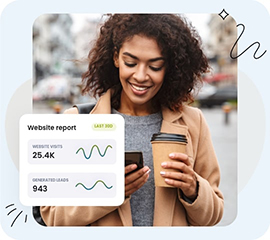Password protection is becoming increasingly important in an era of growing cyber threats. HostPapa takes your online security very seriously. For that reason, we’ve not only explained how to change your password in Website Builder. We’ve also provided you with tips on staying secure online.
To learn how to access your Website Builder to get started, please visit this article.
Don’t forget to keep reading until the end for 9 tips to stay secure online. We’ve also included a quick reference table for you!
Passwords and Website Builder
To change your password:
- Go to Preferences, and select Password.
- Type in your current password in the Current Password section.
- Enter a new password in the New Password section.
- Type in the new password again in the Confirm Password field.
- Click Save.
Another password: The security question
Passwords are great, but adding a security question will help to secure your email privacy. Always select a question that is easy for you to remember but difficult for others to guess.
How to add and update your security question
- Go to Preferences.
- Select Security Question.
- Choose a security question from the drop-down menu.
Password music and movie trivia: Consider avoiding it
Consider choosing a security question that is personal to you, rather than one related to movies or music. To enter a custom question:
- Select Custom Question from the Security Question drop-down menu.
- Enter your question in the Custom Question field.
- Type in an answer to your security question.
- Click Save.
9 Tips to stay secure online
Protecting your online privacy and security has never been more important. Cybercriminals are continually refining their tactics. Adopting cybersecurity habits can reduce your risks. Here are nine practical tips—including password practices—to help you stay secure online.
1. Use strong, unique passwords for every account
Password security is the foundation of your online defence. Weak or reused passwords continue to be a top cause of data breaches and identity theft. Best practices to focus on are:
- Length over complexity: Aim for a minimum of 12—16 characters, using unpredictable combinations of words (passphrases). For example, Coffee!Train!Forest!1234 is both memorable and difficult to crack.
- Uniqueness: Never reuse passwords across services. If one site is breached, attackers can use the same credentials elsewhere.
- Avoid personal info: Don’t use easily obtainable hints like birthdays or names.
- Change defaults: Immediately update the default passwords on any device, including routers and smart home gadgets.
- Password manager: Use a password manager to generate and securely store complex passwords. You only need to remember a single strong master password if you use a password manager.
2. Enable two-factor authentication (2FA)
2FA requires you to confirm your identity. This is done with a second form of verification, such as a code sent to your phone. This precaution makes it difficult for someone to hijack your account, even if they know your password.
Recommended for:
- Banking and financial accounts.
- Email and cloud storage services.
- Social media networks.
- Shopping and payment platforms.
Tip: Check your account settings for Security or Login options to turn on 2FA.
3. Beware of phishing and scams
Phishing attacks attempt to trick you into handing over sensitive information. Phishing involves sending you:
- Fraudulent emails.
- Misleading texts.
- Fake websites.
How to protect yourself:
- Never click suspicious links or open attachments from unknown contacts.
- Favour official websites for account logins. Don’t follow links in emails or messages.
- Check email sender addresses and look for spelling mistakes or urgent demands.
- Use a password manager—many will alert you if a login page doesn’t match a saved, trusted website address.
4. Keep software and devices updated
Cybercriminals exploit outdated software and vulnerabilities.
- Enable automatic updates for your operating system, web browser, antivirus software, and all installed apps.
- Update smart devices (IoT), routers, and firmware whenever prompted.
Regular updates patch security holes and make sure your tech is protected against the latest threats.
5. Use secure Wi-Fi and consider a VPN
Public Wi-Fi can be risky, as it exposes your data to hackers lurking on the same network.
- Only use networks you trust.
- When using public Wi-Fi, avoid accessing sensitive accounts or performing financial transactions.
- Use a Virtual Private Network (VPN) to encrypt your traffic, hiding your activities from prying eyes—even on unsecured networks.
6. Adjust your privacy and security settings
Take control of what you share and with whom.
- Limit the amount of personal information you post and share online.
- Regularly check your privacy settings on social media, apps, and websites.
- Turn off location tracking and restrict unnecessary permissions for apps (like camera, microphone, or contact list access).
7. Be cautious with downloads and links
Malicious Software (Malware) is often disguised as legitimate-looking downloads or attachments.
- Only download apps and files from official sources.
- Avoid pirated software and suspicious websites.
- Scan files with antivirus software before opening them to ensure they are safe.
8. Regularly back up your data
Ransomware and device failures can strike unexpectedly.
- Set up automatic backups to the cloud or an external hard drive.
- Check that you can restore your files when needed.
Backing up data means your important documents, photos, and records can be recovered—no matter what.
9. Learn to spot the warning signs of suspicious activity
Stay alert for signs that your online security has been compromised.
Warning signs include:
- Unfamiliar login notifications or devices connected to your accounts.
- Password reset requests you didn’t initiate.
- Unexpected purchases or bank transactions.
- Friends are receiving strange messages from your accounts.
If you suspect a breach:
- Immediately change your password(s).
- Enable or review 2FA settings.
- Notify the relevant service providers.
Quick reference table
| TIP | ACTION | |
| 1. | Strong, unique passwords: | Use long passphrases and a password manager. |
| 2. | Two-factor authentication: | Enable 2FA on all important accounts. |
| 3. | Resist phishing: | Stay cautious of suspicious links or requests. |
| 4. | Keep everything updated: | Auto-update software and devices. |
| 5. | Use safe Wi-Fi and VPN: | Stick to trusted networks, use VPN if needed. |
| 6. | Privacy settings: | Limit sharing, lock down app permissions. |
| 7. | Secure downloads: | Download only from official sources. |
| 8. | Back up your data: | Use cloud/external backup, test restores. |
| 9. | Monitor for suspicious acts: | Watch for hacking signs, change passwords fast. |
HostPapa’s final thoughts
The digital world is always evolving, but so are the tools and strategies to keep your data safe. Regularly review your online habits and incorporate these nine tips into your routine.
Taking these proactive steps will go a long way in protecting your personal information, digital identity, and peace of mind.
If you need help with your HostPapa account, please open a support ticket from your dashboard.




